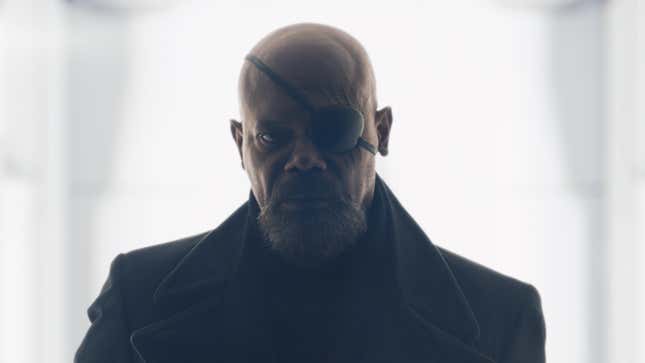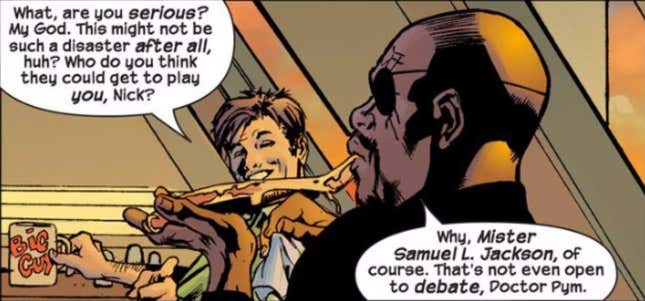
In the beginning, there was Fury. Samuel L. Jackson made his first appearance as the enigmatic director of S.H.I.E.L.D. 15 years ago, in a post-credits scene at the end of Iron Man. “You’ve become part of a bigger universe,” he told Robert Downey Jr.’s Tony Stark. “You just don’t know it yet.” He might as well have been talking directly to the audience.
That moment launched the franchise we’ve come to know as the Marvel Cinematic Universe. Of course, the MCU has come a long way since then, and so has Nick Fury. As of now, he’s appeared in 11 films (The Marvels will make it an even dozen when it comes out in November), plus a handful of TV series and shorts, usually lurking in the background, influencing events with a subtle hand.
After a decade and a half in the shadows, though, Fury finally steps into a starring role for Secret Invasion, a new series premiering June 21 on Disney+. Before you sit down to watch Marvel’s take on the spy thriller genre, it may be helpful to track Fury’s winding journey from soldier to spy to fugitive and back to spy again. If you’ve caught all of his MCU appearances on the big and small screen, this refresher may help put them in context. And if you haven’t, it should bring you up to speed on everything he’s been up to lately.
Phase Zero: Marvel Comics origins
Many great comic-book characters have convoluted origins, and Nick Fury is no different. Originally created by Marvel legends Jack Kirby and Stan Lee, he first appeared in 1963 as the star of his own series, Sgt. Fury And His Howling Commandos. Up until 2001, the character was a cigar-chomping Italian-American tough guy who served in World War II, then became a CIA operative, then the leader of a secretive government agency called S.H.I.E.L.D. (the meaning behind the acronym has changed so many times it scarcely matters what it stands for anymore). If you’re wondering how he stayed in such great shape all that time, the answer is: it’s a comic book, don’t worry about it. (The actual answer is an immortality drug called the infinity formula, if you really wanna know.)
When Marvel launched its Ultimate imprint in 2001, Nick Fury was among the heroes reimagined for a modern era. His redesign was based on the likeness of Samuel L. Jackson. This was years before Jackson had even been approached about playing the character on screen. Before that, the only other actor to portray him in live-action was David Hasselhoff, who starred in a made-for-TV movie on Fox in 1998 titled Nick Fury: Agent of S.H.I.E.L.D. After Fury was introduced in the MCU, Jackson became so closely associated with the character that Marvel retired the original version in the comics and replaced him with his son, Nick Fury Jr., who bore a strong resemblance to the Ultimate character, and thus the actor who inspired him. Jackson’s Fury had come full circle.

Phase One: The Avengers Initiative
The MCU wouldn’t be what it is without Nick Fury. There certainly wouldn’t be any Avengers without him. It was Fury who came up with the idea for the Avengers Initiative in the mid-’90s, after meeting Carol Danvers (Brie Larson), a.k.a. Captain Marvel, and realizing that the planet needed a powerful defense force to protect it from otherworldly threats. He would later describe it as an idea “to bring together a group of remarkable people, to see if they could become something more. To see if they could work together when we needed them to. To fight the battles that we never could.”
As we’ve already mentioned, Fury first approached Tony Stark about the Avengers Initiative at the end of Iron Man in 2008. He plays a bigger role in Iron Man 2, actively assessing Stark’s suitability for the team with the help of undercover S.H.I.E.L.D. agent Natasha Romanoff (Scarlett Johansson), codenamed Black Widow. Fury ultimately determines that Stark is not a team player, but brings him on as a consultant anyway.
His next recruitment effort is focused on Steve Rogers (Chris Evans) at the end of Captain America: The First Avenger, after he’s recovered from the ice that’s kept him in stasis for almost 70 years. The last few pieces fall into place in The Avengers, with the additions of Bruce Banner (Mark Ruffalo), Thor (Chris Hemsworth), and Hawkeye (Jeremy Renner). Fury brings them together and gives them something to fight for, but ultimately couldn’t keep the team under his control. With Phase One complete, it was on to more shocking revelations and perilous endeavors.
Phase Two: Schrödinger’s Fury
One of the most significant canon events in Nick Fury’s story happened in Captain America: The Winter Soldier. With the discovery that S.H.I.E.L.D. had been infiltrated by agents of Hydra, Fury becomes a target for elimination by corrupt bureaucrat Alexander Pierce (Robert Redford). He escapes elimination by faking his own death, taking Pierce by surprise before taking him out. Only a handful of trusted allies know the truth, including Steve, Natasha, Sam Wilson (Anthony Mackie), and Maria Hill (Cobie Smulders).
On his way out the door, metaphorically speaking, Fury also pays a visit to his former protege Phil Coulson (Clark Gregg) and gives him a digital toolbox full of classified information. He orders him to rebuild S.H.I.E.L.D. as its new director (though his authority to do that comes into question later). With that accomplished, he heads underground, officially deceased but continuing to operate as a free agent on his own terms.
Fury pops up again in Clint Barton’s barn in Avengers: Age of Ultron, to scold Tony for building a sentient murderbot and rally the Avengers after their psychologically crushing defeat at the hands of Wanda Maximoff (Elizabeth Olsen). He also helps them evacuate the residents of Sokovia in the midst of Ultron’s attack by providing a helicarrier to take them to safety. That’s the last we see of him for some time.

Phase Three: Blipped and replaced
The next time Fury appears (in chronological time), it’s in another post-credits scene at the end of Avengers: Infinity War. He becomes one of the unlucky half of the population to disappear after Thanos’ snap, but not before he sends out a very important distress call via modified pager. That hastily composed message brings Captain Marvel back to Earth and into the Avengers fold. Fury is brought back by Hulk’s snap in Avengers: Endgame, along with everyone else. His appearance at Tony Starks’ funeral seems to indicate that he’s no longer pretending to be dead, or at least the knowledge of his existence has expanded to a wider circle.
In Spider-Man: Far From Home, Fury investigates a series of attacks by elemental beings in various locations around the world, and recruits Spider-Man (Tom Holland) to help defeat them. But all is not what it seems. The monsters are actually projections created by an egomaniacal scientist named Quentin Beck (Jake Gyllenhaal). Also, the Fury we see in the film isn’t actually Fury. He’s Talos (Ben Mendelsohn), a shapeshifting Skrull sent to take his place while Fury vacations on a S.W.O.R.D. space station.
Phase Four and beyond: What’s next?
With the exception of a few episodes of the animated series What If...? Nick Fury was largely absent for most of Phase Four. The last we saw of him, he was getting ready to end his space sabbatical and get back to work. Now that Phase Five is underway, we expect to see him back to his old secretive ways, making surprise appearances in post-credit scenes and tying the disparate threads of the MCU together as it builds toward the next big team-up. We’ve already seen him in trailers for The Marvels, but there are still six episodes of Secret Invasion to get through before we go back to space. The timeline’s still a bit murky, but it will eventually sort itself out. Until then, the omniscient spy whose “secrets have secrets” is keeping it to himself.